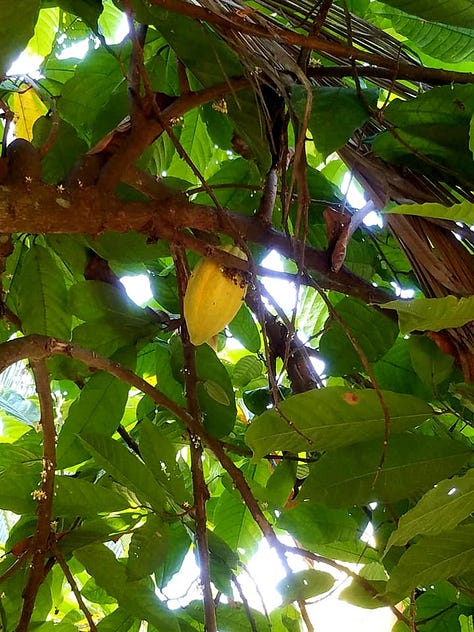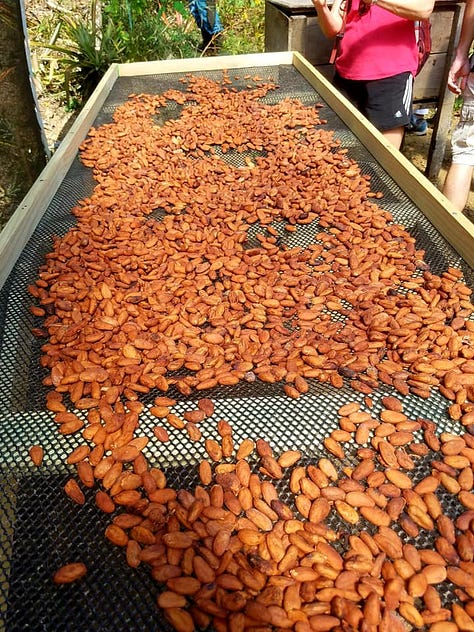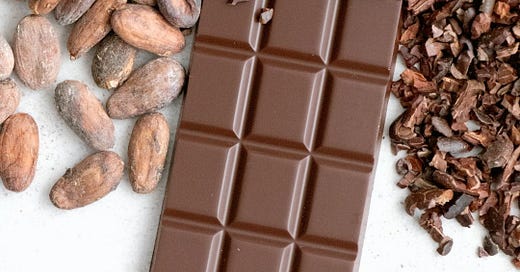One of the questions I’m commonly asked when talking about the benefits of dark chocolate and cocoa/cacao is: Is there a difference between cocoa and cacao?
The short answer is YES.
To better understand the difference between cocoa and cacao, it can be helpful to know how chocolate is made.
My husband and I went to Costa Rica for our honeymoon in 2019 and were able to tour an organic cacao farm. We got to walk through the plantation of cacao trees, taste the sweet seeds inside the pods, and experience the entire process of how chocolate is made from start to finish. I’ve included the pictures below to help you visually see and understand the process as well.
Here are some main key points to know about cacao/chocolate:
All chocolate, cocoa powder, and cacao powder come from the cacao tree.
The cacao tree produces large pods of fruit (picture #1) that contain 35-50 seeds (cacao beans) inside them. The seeds are surrounded by a sweet, slimy pulp.
The beans are removed from the pod and put into boxes to ferment for 5 days which increases the sweet/chocolate flavor, then they’re laid out to dry in the sun for 7-10 days (picture #2).
Once dried, the beans are crushed into smaller pieces (picture #3).
Next, the shells are separated from the nibs by shaking the crushed pieces (picture #4).
The nibs are then ground into chocolate in its purest form (pictures #5 & 6).






At this point you have 100% dark chocolate (sometimes referred to as “cocoa liquor”), which naturally contains both cocoa butter and cocoa solids. This can then be turned into chocolate by adding sugar and milk, or turned into powder.
The major differences between cocoa and cacao occur in this process of turning the cacao solids into powder.
To make cocoa or cacao powder, the cacao butter and cacao solids need to be separated, and the solids turned into a powder.
Cacao powder is made by cold-pressing the raw cacao beans to separate the cacao butter from the solids. The solids are then pulverised to create a powder. The antioxidants and nutrients are significantly higher in cacao powder since no heat was used in the process.
Cocoa powder is processed at high temperatures, which lowers the antioxidant content and total nutritional value.
In addition, some cocoa powders are “Dutch-processed” or “alkalized” with an alkalizing agent (either potassium bicarbonate or sodium bicarbonate). This process reduces the natural acidity of cocoa, giving it a less bitter taste and darker color.
This process of alkalizing or “Dutch processing” the cocoa powder further reduces the antioxidant and mineral content. For example, one study determined that 60% of cacao’s natural antioxidants were destroyed by light dutching and 90% were destroyed by heavy dutching.
To put this into perspective, 100g of cacao powder has an ORAC antioxidant score of 96,000 while cocoa powder has an ORAC score of 26,000. This means that cacao powder has nearly 4x more antioxidants than cocoa powder.
In addition, raw cacao powder has 126% more iron, 149% more magnesium, and 136% more potassium than processed cocoa.
Look for the term “Dutch processed” or “processed with alkali” on the ingredients list to identify if the cocoa has been treated with this process, indicating lower antioxidant and nutritional value.
Now that you know the difference between cacao powder and cocoa powder, with cacao powder being superior, let’s look at the benefits of cacao.
Benefits Of Cacao & Dark Chocolate
1. Anti-Inflammatory
As mentioned above, cacao powder is one of the richest sources of antioxidants, with an ORAC antioxidant score of 96,000 per 100 grams (about 1 cup). This means that just one tablespoon of cacao powder has an ORAC score of around 6,000 which is higher than a cup of most fruits and vegetables.
The primary antioxidants found in cacao powder (and thus dark chocolate) are flavanols, including catechin, epicatechin, and procyanidins which help to reduce oxidative stress and protect our cells from damage (contributing to longevity).
2. High In Magnesium
Cacao is also one of the best sources of magnesium, providing 65 mg of magnesium in 1 oz, or about one square, of 70-85% dark chocolate. This is about 15% the RDA per square of chocolate.
Magnesium is involved in over 300 processes in the human body, and approximately 50% of Americans are deficient in it.
3. Natural Adaptogen - Reduces Stress & Boosts Mood
According to the book Healing Adaptogens, cacao is “the oldest adaptogen with a recorded history of human use” that’s been used for over 15,000 years. Adaptogens are defined as substances that help the body manage stress and restore balance after a stressful situation.
Cacao contains many compounds that contribute to its adaptogenic properties, including Theobromine, which is associated with increased energy, stamina, immune function, mood, and cognitive function.
In addition, Phenylethylamine, or PEA, is a compound found in cacao that is sometimes referred to as the "love molecule." PEA stimulates the release of endorphins, which are our brain's natural feel-good chemicals.
4. Brain-Protective Properties
Research shows that the flavanols in cacao enhance blood flow to the brain and promote memory, learning, and cognitive function.
One randomized controlled trial looked at the effect of dark chocolate consumption on cognitive function in 88 healthy middle-aged adults between the ages of 40 to 65.
Half of these participants ate five pieces of 72% dark chocolate per day for four weeks; the other half did not eat any chocolate. Researchers evaluated fatigue levels, cognitive function, and brain health with questionnaires, cognitive tests, as well as MRI scans.
At the end of the study, the participants who consumed the dark chocolate reported less fatigue and showed improved executive functioning (such as problem-solving and focus), memory, and increased gray matter volume, which is an important indicator of brain function.
Other research showed “almost immediate improvements in working memory” and cognitive function from consuming a single dose of dark chocolate (1. oz or about one square), peaking at about 2 hours after consumption. This is due to the large increase in blood flow to the brain, which delivers oxygen and nutrients for brain performance.
5. Promotes Heart Health
The antioxidants and nutrients in cacao are associated with reducing the risk of heart disease by improving blood flow, reducing blood pressure, and reducing the risk of blood clots.
The flavanols in dark chocolate increase nitric oxide, which causes the blood vessels to relax and widen, leading to improvements in blood flow and reduced blood pressure.
In addition, the magnesium in dark chocolate also helps to lower blood pressure and relax the heart muscle.
6. Prebiotic For Gut Health
Cacao is also a prebiotic for gut health due to the presence of fiber and polyphenols that it contains.
A 1-oz. serving of dark chocolate contains up to 5 grams of fiber per serving (the darker the chocolate, the more fiber it contains), and a tablespoon of cacao powder contains 2 grams of fiber.
One study found that people who consumed cocoa high in antioxidant flavanols for four weeks experienced significant increases in the populations of beneficial bacteria in their gut, while reducing the presence of harmful bacteria like clostridia. In addition, they also had reductions in the inflammatory marker CRP (C-reactive protein).
Other Essential Nutrients
One oz. of 85% dark chocolate also contains 2.7 mg of iron (15% RDA), 220 mg potassium (4% RDA), as well as trace amounts of vitamins A, B, E, and K.
Sources of Cacao
Cacao is found in dark chocolate, cacao powder, and cacao nibs. Here’s what to look for and how to use each:
Dark chocolate: enjoy a square or two of >72% dark chocolate when you’re craving something sweet. Look for dark chocolate that’s not processed with alkali and has less than 6 grams of added sugar per serving. I like Alter Eco 85% dark chocolate which has only 4 grams of added sugar and 4 ingredients: organic cacao beans, organic cacao butter, organic raw cane sugar, and organic vanilla beans.
Cacao powder: add a tablespoon into smoothies, and use it for any anything that call for cooca powder like brownies, breads, muffins, cakes, cookies, and hot chocolate. Look for cacao powder that’s not dutch-processed or processed with alkali.
Cacao nibs: I like to add cacao nibs to oatmeal, energy balls, granola, and yogurt. They’re also great sprinkled onto dates with peanut butter or apple with peanut butter for a natural chocolate flavor without the added sugars.
Main Takeaways
The main difference between cacao and cocoa is how they’re processed which impacts the nutritional quality.
Cacao is minimally processed and therefore significantly higher in antioxidants and nutrients than cocoa, with up to 90% more antioxidants, 126% more iron, 149% more magnesium, and 136% more potassium than processed cocoa.
Cacao has many benefits on our health including anti-inflammatory properties, rich in essential nutrients like magnesium, a natural adaptogen, improves gut health, and promotes brain and heart health.
Enjoy a serving of cacao daily if desired in the form of >72% dark chocolate, cacao powder, or cacao nibs since it’s full of antioxidants and other nutrients that benefit our health.
-xo Kate





